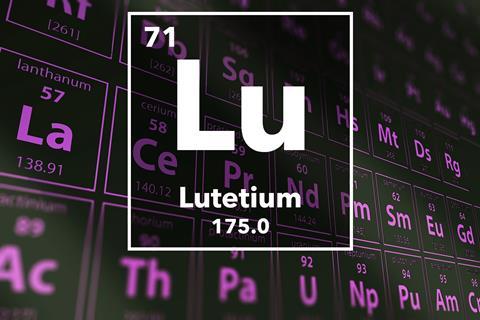Meera Senthilingham
This week: an element that was worth the wait. Here's Simon Cotton:
Simon Cotton
All chemists have their favourite elements, often for some personal reasons. In my case, that would be iron, as I spent three years of a PhD working on iron compounds. But it could also be cobalt, because cobalt is used to make the blue colour in many of my favourite stained glass windows in churches and cathedrals. Or it could be the last of the lanthanides – lutetium.

After completing my PhD, I carried out postdoctoral research trying to make new organometallic compounds of the metallic elements with electrons in their 4f subshells, known as the lanthanides. Until then, all the structures of these compounds that had been isolated contained organic rings bound side-on, or as organometallic chemists say, polyhapto.
This research was, well, challenging. The compounds did not just catch fire in air, sometimes they caught fire in the inert atmospheres of glove boxes. It took me two years but eventually I managed to make compounds of lutetium, and also ytterbium. My colleague, Alan Welch, did an X-ray diffraction study using crystals of the lutetium compound, and found that the rings were bound in a way that had not been seen in lanthanides before, end-on or monohapto-.
This discovery was particularly pleasing because it was also the first four coordinate compound of any lanthanide. Mind you, what put it into perspective was that on the other side of the bench from me, an extremely talented and productive Indian chemist named Joginder Singh Ghotra made the first three coordinate compounds for yttrium and all the 14 stable lanthanides, not just lutetium.
So I've got good memories of lutetium, but what does lutetium matter to other chemists?
All the lanthanides took a long while to be discovered. Partly because neighbouring lanthanides tend to be very, very similar chemically, making them hard to separate. Another problem was that no one knew how many there were meant to be, as there were no theories of electronic structure or atomic number at the time.

Lutetium was actually the last lanthanide to be isolated in 1907; and was simultaneously discovered by three chemists working in different parts of the world.
They were the Austrian Carl Auer von Welsbach, the American Charles James, and Georges Urbain from France. Urbain was first to successfully separate lutetium from its neighbour, ytterbium, so he was given the privilege of naming the element. And being a good Frenchman, he selected the Latin name for Paris, lutetia.
So why was lutetium the last lanthanide to be discovered? Two reasons. As the atomic number of an element increases, its abundance decreases. Secondly elements with even atomic numbers, like ytterbium, are more abundant than elements with odd atomic numbers, such as lutetium. This is summarised in what is called the Oddo-Harkins rule, which sounds like something out of a Tolkien novel.
Additionally because lutetium has a filled 4f (NB, Simon Cotton says 4d here) subshell, it is spectroscopically rather transparent and it does not form coloured compounds, and so it is quite easy to overlook.
There is more than a hundred times more cerium, the most abundant lanthanide, in the earth than there is lutetium, the least abundant. This makes lutetium and its compounds rather expensive. Having said that, it is more abundant in the earth than elements like silver or gold, or the platinum metals.
Lutetium is the last of its family and the smallest. In size it is much nearer to yttrium and scandium, so some versions of the Periodic Table have lutetium directly under Sc and Y, preceded by the lanthanides from lanthanum to ytterbium.
The pure element is a silvery metal, and is similar to calcium and magnesium in its reactivity.
Lutetium and its compounds have found some applications, the most important of these is the use of the oxide in making catalysts for cracking hydrocarbons in the petrochemical industry. But there are other more specialist uses, such as using the radioactive lutetium-177 isotope in cancer therapy. Lutetium ions were also used to dope gadolinium gallium garnet to make magnetic bubble computer memory that was eventually replaced by modern-day hard drives.

Lutetium triflate has also been found to be a very effective recyclable catalyst for organic synthesis in aqueous systems – it avoids the use of organic solvents, giving it green credentials – but because of its cost, it will never be as popular as the triflates of some other lanthanides.
It's fair to say that lutetium is still an element looking for its niche in the world, but I predict that more specialist uses will be forthcoming as the twenty-first century unfolds.
Meera Senthilingham
So keep your eyes peeled for lutetium popping up in medicine and our industries in the future. That was Simon Cotton with the long-awatied chemistry of the lanthanide lutetium. Now, next week, we're making new elements.
Andrea Sella
This is not work for the lone experimenter working in a shed somewhere. These are experiments of extraordinary subtlety and complexity. And the problem is not just making the new element but also figuring out what you've got at the end. The problem is that you only make a few atoms at a time and these products tend to be spectacularly unstable so you sometimes have only a few milliseconds in which to work out what you've got. It's complex. It's expensive. And very, very clever. And each new atom really is a whole new chemical world to explore. Can it be any wonder that it attracts fortune seekers?
Meera Senthilingham
And join University College London's Andrea Sella to find out how elements 116 and 118 were discovered, as well as which fortune seekers found them, in next week's Chemistry in its element. Until then, I'm Meera Senthilingham and thank you for listening.













No comments yet